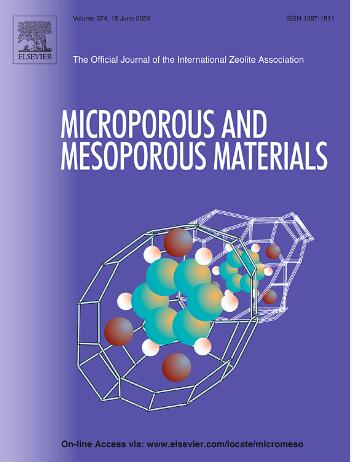Comparative study on adsorption performance of Pb(II) using fly ash-based mesoporous silica through sol-gel method with different aging temperature
IF 4.8
3区 材料科学
Q1 CHEMISTRY, APPLIED
引用次数: 0
Abstract
The preparation of mesoporous silica materials from fly ash for the adsorption of heavy metals represents a significant approach to resource utilization. In this study, the sol-gel process was employed to synthesize amino-functionalized mesoporous silica with varying pore structure properties (denoted as MS-NH2-T, where T = 20 °C, 40 °C, and 90 °C) by controlling the aging temperature. The effects of adsorption conditions on the adsorption efficiency of Pb(II) were investigated, and the differences in the adsorption behavior of amino-functionalized mesoporous silica with distinct pore structures were compared and analyzed using typical adsorption isotherms, adsorption kinetics, and rate-limiting adsorption kinetics models. The results indicated variations in specific surface area (625 m2 g−1, 640 m2 g−1, and 345 m2 g−1), average pore size (3 nm, 7 nm, and 15 nm), and total pore volume (0.5 cm3 g−1, 1.0 cm3 g−1, and 1.3 cm3 g−1) among the mesoporous silica synthesized at different aging temperatures. Following amino modification, Pb(II) can be adsorbed through mechanisms such as pore adsorption, electrostatic attraction, and complexation. The adsorption capacities of the amino-functionalized mesoporous silica with varying pore structures were found to be 330 mg g−1, 303 mg g−1, and 204 mg g−1, respectively. Furthermore, the adsorption rate constant of the MS-NH2-90 material, which features a larger pore size and volume, was determined to be 0.0290 and 0.0008, with a time to reach adsorption equilibrium of 60 min, outperforming the MS-NH2-20 and MS-NH2-40 materials under identical conditions (initial concentration of 300 mg L−1). Overall, mesoporous silica with a larger specific surface area demonstrates a higher adsorption capacity, while materials with increased pore size and pore volume exhibit faster adsorption rates. The findings of this study will assist in the selection of the most appropriate amino-functionalized mesoporous silica materials for the adsorption of Pb(II), based on whether the emphasis is on adsorption rate or capacity.

求助全文
约1分钟内获得全文
求助全文
来源期刊

Microporous and Mesoporous Materials
化学-材料科学:综合
CiteScore
10.70
自引率
5.80%
发文量
649
审稿时长
26 days
期刊介绍:
Microporous and Mesoporous Materials covers novel and significant aspects of porous solids classified as either microporous (pore size up to 2 nm) or mesoporous (pore size 2 to 50 nm). The porosity should have a specific impact on the material properties or application. Typical examples are zeolites and zeolite-like materials, pillared materials, clathrasils and clathrates, carbon molecular sieves, ordered mesoporous materials, organic/inorganic porous hybrid materials, or porous metal oxides. Both natural and synthetic porous materials are within the scope of the journal.
Topics which are particularly of interest include:
All aspects of natural microporous and mesoporous solids
The synthesis of crystalline or amorphous porous materials
The physico-chemical characterization of microporous and mesoporous solids, especially spectroscopic and microscopic
The modification of microporous and mesoporous solids, for example by ion exchange or solid-state reactions
All topics related to diffusion of mobile species in the pores of microporous and mesoporous materials
Adsorption (and other separation techniques) using microporous or mesoporous adsorbents
Catalysis by microporous and mesoporous materials
Host/guest interactions
Theoretical chemistry and modelling of host/guest interactions
All topics related to the application of microporous and mesoporous materials in industrial catalysis, separation technology, environmental protection, electrochemistry, membranes, sensors, optical devices, etc.
文献相关原料
公司名称
产品信息
阿拉丁
lead nitrate
阿拉丁
3-aminopropyltriethoxysilane
阿拉丁
ammonium hydroxide
阿拉丁
sulfuric acid
 求助内容:
求助内容: 应助结果提醒方式:
应助结果提醒方式:


